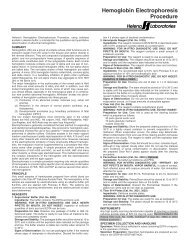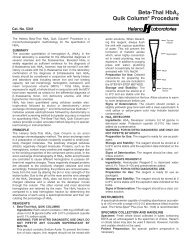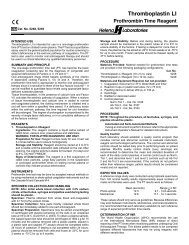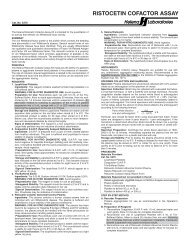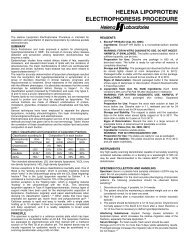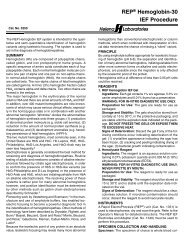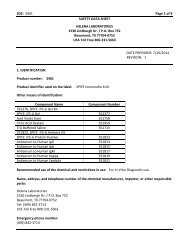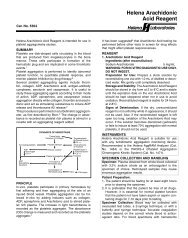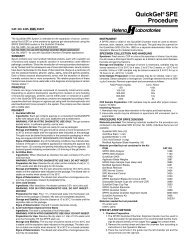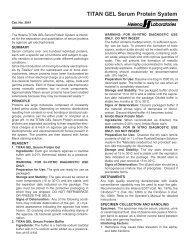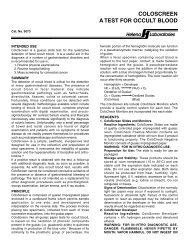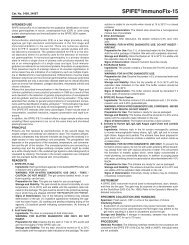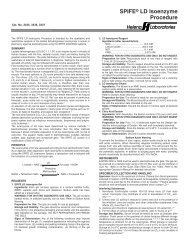QuickGel® CK Vis Isoenzyme Procedure - Helena
QuickGel® CK Vis Isoenzyme Procedure - Helena
QuickGel® CK Vis Isoenzyme Procedure - Helena
Create successful ePaper yourself
Turn your PDF publications into a flip-book with our unique Google optimized e-Paper software.
Cat. No. 3334, 3534TQuickGel ® <strong>CK</strong> <strong>Vis</strong><strong>Isoenzyme</strong> <strong>Procedure</strong><strong>Helena</strong>LaboratoriesThe QuickGel ® <strong>CK</strong> <strong>Vis</strong> <strong>Isoenzyme</strong> <strong>Procedure</strong> is intended for the qualitativeand quantitative analysis of the creatine phosphokinase isoenzymes inserum by agarose electrophoresis using the SPIFE 2000/3000 system orQuickGel Chamber.Cat. No. 3334 - SPIFE 2000/3000Cat. No. 3534T - QuickGel ChamberSUMMARYCreatine phosphokinase (<strong>CK</strong>) (EC 2.7.3.2) is an energy transfer enzymewhich catalyzes the reversible reaction<strong>CK</strong>ADP + creatine phosphateATP + creatine<strong>CK</strong> exists primarily in skeletal muscle, cardiac muscle and the brain,with small amounts in several other tissues. 1 A number of diverse clinicalepisodes such as surgical procedures, intramuscular injections and myocardialinfarct induce increased <strong>CK</strong> activity in the serum. 2, 3 The source ofelevated <strong>CK</strong> activity may be narrowed by isoenzyme assessment. Thereare two molecular <strong>CK</strong> subunits, designated M and B, the combinations ofwhich produce three isoenzymes: <strong>CK</strong>-MM (isolated primarily from skeletalmuscle), <strong>CK</strong>-MB (myocardium) and <strong>CK</strong>-BB (primarily from the brain). 3<strong>CK</strong> isoenzyme analysis is one of the important procedures used in thedetection of myocardial damage. 4 After an acute myocardial infarction (MI),<strong>CK</strong>-MB appears in the serum in approximately 4 to 6 hours, reaches peakactivity at 18 to 24 hours, and may disappear completely within 72 hours.Within the first 48 hours after MI, <strong>CK</strong>-MB is present in 100% of the patients1, 3, 7with MI as well as in some cases of severe coronary insufficiency.Definitive laboratory testing in the diagnosis of MI is accomplished byperforming studies of <strong>CK</strong> isoenzymes in conjunction with lactate dehydrogenase(LD) isoenzymes. 3, 5-8 The specificity and sensitivity achievedwith these two tests has eliminated the necessity for additional enzymestudies in accurately diagnosing MI. 6 The most important considerationin the interpretation of <strong>CK</strong> and LD isoenzyme patterns is the detection ofthe characteristic change of pattern of multiple examinations (the relativelyfast appearance and disappearance of <strong>CK</strong>-MB and the flip of LD1 andLD2). 1, 3, 35 Persistent elevation in <strong>CK</strong>-MB is not indicative of myocardialinfarct. <strong>CK</strong>-MB may be helpful in diagnosing a small infarct in which total<strong>CK</strong> never exceeds the upper limit of normal. 9<strong>CK</strong> produced by myocardium is only 25 to 40% <strong>CK</strong>-MB, the remainderbeing <strong>CK</strong>-MM. 1, 4 Therefore, an elevation in <strong>CK</strong> due to myocardial infarctionproduces not only a rise in <strong>CK</strong>-MB but in <strong>CK</strong>-MM as well. 3 The isoenzymesof <strong>CK</strong> have been assessed by various methods. 10-19 Electrophoresis offersthe distinct advantage of complete separation of the isoenzymes withoutrisk of carryover. 3PRINCIPLEThe isoenzymes of <strong>CK</strong> are separated according to their electrophoreticmobility on agarose gel. After separation the gels are incubated with theSPIFE <strong>CK</strong> <strong>Isoenzyme</strong> Reagent which utilizes the following reactions:Creatine phosphate + ADPHexokinaseATP + D-glucoseD-G-6-P + NADNADH + H +G-6-PDPMS<strong>CK</strong>Creatine + ATPD-Glucose-6-phosphate + ADPNADH + 6 phosphogluconate + H +NAD + FormazanREAGENTS1. QuickGel <strong>CK</strong> GelIngredients: Each gel contains agarose in a AMP/MOPSO buffer.Sodium azide has been added as a preservative.WARNING: FOR IN-VITRO DIAGNOSTIC USE. Refer to Sodium AzideWarning.Preparation for Use: The gels are ready for use as packaged.Storage and Stability: The gels should be stored at room temperature(15 to 30°C), in the protective packaging, and are stable until theexpiration date indicated on the package. DO NOT REFRIGERATE ORFREEZE THE GELS.Signs of Deterioration: Any of the following conditions may indicatedeterioration of the gel: (1) crystalline appearance indicating the agarosehas been frozen, (2) cracking and peeling indicating drying of theagarose, (3) bacterial growth indicating contamination, (4) thinning of gelblocks.2. <strong>CK</strong> <strong>Vis</strong> <strong>Isoenzyme</strong> ReagentIngredients:Adenosine 5'-diphosphate (ADP).................................................. 12 mMCreatine phosphate....................................................................... 90 mMAdenosine 5'-monophosphate (AMP)........................................... 15 mMMagnesium Acetate....................................................................... 60 mMDiadenosine pentaphosphate...................................................... 0.1 mMNicotinamide adenine dinucleotide (NAD).................................... 10 mMD-glucose...................................................................................... 60 mMGlucose-6-phosphate dehydrogenase(L.mesenteroides).................................................................7,500 IU/LHexokinase (Yeast)..................................................................9,000 IU/LPMS............................................................................................ 0.15 mMBovine Serum Albumin (BSA)....................................................... 4.5 g/LWARNING: FOR IN-VITRO DIAGNOSTIC USE ONLY. DO NOT INGEST.Preparation for Use: Reconstitute one vial of <strong>CK</strong> Reagent with 1.5 mL of<strong>CK</strong> Diluent.Storage and Stability: The dry reagent should be stored at 2 to 8°C andis stable until the expiration date on the vial. Reconstituted reagent isstable for 1 hour at 15 to 30°C.Signs of Deterioration: If the unreconstituted reagent is not a uniformlywhite or slightly off white dry powder, it should not be used.3. <strong>CK</strong> DiluentIngredients: The diluent contains MES, sucrose, Triton X and sodiumazide added as a preservative.WARNING:FOR IN-VITRO DIAGNOSTIC USE. DO NOT INGEST. Referto Sodium Azide Warning.Preparation for Use: The diluent is ready for use as packaged.Storage and Stability: The diluent should be stored at 2 to 8°C and isstable until the expiration date indicated on the vial.Signs of Deterioration: Discard the diluent if it shows signs of bacterialgrowth.4. <strong>CK</strong> ChromogenIngredients: The chromogen contains 0.023 g Tetranitro Blue Tetrazolium(TNBT) per mL Dimethyl-formamide.WARNING: FOR IN-VITRO DIAGNOSTIC USE. DO NOT INGEST– IRRITANT.Preparation for Use: Add 150 µL of Chromogen to each vial of reconstitutedReagent, invert and use immediately.Storage and Stability: The Chromogen should be stored at 2 to 8°C andis stable until the expiration date indicated on the vial.Signs of Deterioration: The product should be discarded if it showsnoticeable signs of turbidity.5. <strong>CK</strong> ActivatorIngredients: The Activator contains 114 mM BME (Beta MercaptoEthanol) in Tris base.WARNING: FOR IN-VITRO DIAGNOSTIC USE. DO NOT INGEST.Preparation for Use: The product is ready for use as packaged.Storage and Stability: The Activator should be stored at 2 to 8°C and isstable until the expiration date indicated on the vial.Signs of Deterioration: The product should be discarded if it showsnoticeable signs of turbidity.6. Citric Acid DestainIngredients: After dissolution, the destain contains 0.3% (w/v) citric acid.WARNING: FOR IN-VITRO DIAGNOSTIC USE. DO NOT INGEST -IRRITANT.Preparation for Use: Pour 11 L of deionized water into the Destain vat.Add the entire package of Destain. Mix well until completely dissolved.Storage and Stability: Store the Destain at 15 to 30°C. It is stable untilthe expiration date on the package.Sodium Azide WarningTo prevent the formation of toxic vapors, sodium azide should not bemixed with acidic solutions. When discarding reagents containing sodiumazide, always flush sink with copious quantities of water. This will preventthe formation of metallic azides which, when highly concentrated in metalplumbing, are potentially explosive. In addition to purging pipes with water,plumbing should occasionally be decontaminated with 10% NaOH.INSTRUMENTSA SPIFE 2000 or 3000 Analyzer or the QuickGel Chamber must be used toelectrophorese and dry the gel. Refer to the Operator's Manual for detailedoperating instructions.
SPECIMEN COLLECTION AND HANDLINGSpecimen: Serum is the specimen of choice.Collection of Specimen: Proper timing of specimen collections is criticalto accurate interpretation of <strong>CK</strong> isoenzyme analysis. A blood specimenshould be obtained immediately upon admission of the patient to the hospitaland at 8 to 12 hour intervals thereafter for a minimum of 36 hours.Interfering Substances:1. Mature red blood cells contain no <strong>CK</strong>; however, some of the side reactionsmay occur in the coupled enzyme assay resulting in lower estimated<strong>CK</strong> activity. Non-hemolyzed samples are, therefore, preferred. 202. <strong>CK</strong> is inactivated by heat. 203. Repeated freezing and thawing destroys activity (see Serum Storage).4. For the effects of various drugs on <strong>CK</strong> activity, refer to Young, et al. 21Serum Storage:1. The blood specimen should be refrigerated (2 to 8°C) immediately aftercollection. Serum should be separated from the red blood cells as soonas possible.2. Serum specimens may be stored at 2 to 8°C for up to 48 hours. 223. Specimens may be stored frozen (-20°C) for up to two weeks. 22 Frozenspecimens should be thawed at room temperatures and should neverbe placed in a 30 to 37°C water bath for thawing. Repeated freezing andthawing destroys <strong>CK</strong> activity and should be avoided.PROCEDURE FOR SPIFEMaterials Provided: The following materials are provided in the QuickGel<strong>CK</strong> <strong>Vis</strong> <strong>Isoenzyme</strong> Kit (Cat. No. 3334). Individual items are not available.QuickGel <strong>CK</strong> Gels (10)<strong>CK</strong> <strong>Vis</strong> Reagent (10 x 1.5 mL)<strong>CK</strong> Diluent (1 x 15 mL)<strong>CK</strong> Chromogen (1 x 1.5 mL)<strong>CK</strong> Activator (1 x 0.2 mL)QuickGel Blotter C (10)Citric Acid Destain (1 pkg)Applicator Blade Assembly-20 SampleMaterials provided but not contained in the kit:Cat. No.SPIFE 3000 1088SPIFE 2000 1130Disposable Sample Cups 3369Quick Scan 2000 1660<strong>CK</strong>/LD Control 5134REP Prep 3100Gel Block Remover 1115SPIFE 3000/REP 3 Reagent Spreaders 3706Applicator Blade Weights 3387SPIFE Reagent Spreader 3386QuickGel Dispo Cup Tray 3353SPIFE QuickGel Electrode 1111SPIFE QuickGel Holder 3358SPIFE QuickGel Chamber Alignment Guide 86541003Chamber Cover8JP34012SPIFE Applicator Blades 3450STEP-BY-STEP METHODI. Stainer PreparationNOTE: If a SPIFE procedure requiring a stain has been run prior torunning the <strong>CK</strong> gels, the stainer unit must be cleaned/washed beforewashing the <strong>CK</strong> gel.SPIFE 3000The SPIFE has an automatic wash cycle prompted by initiation of a testwhich does not use the stainer unit for staining when the previous testdid use the stainer for staining. To avoid delays after electrophoresis,this wash cycle should be initiated at least seven (7) minutes priorto the end of the run. To verify the status, press the TEST SELECT/CONTINUE button on the stainer until the appropriate test is selected.Place an empty Gel Holder in the stainer unit. If cleaning is required,the “Wash 1” prompt will appear, followed by “Plate out, Holder in”prompts. Press “Continue” to begin the stainer wash. The cleaningprocess will complete automatically in about 7 minutes. The unit is thenready to process the gel after electrophoresis.SPIFE 2000 If utilizing the unit for both stained and non-stained gels, log usage todetermine when cleaning is necessary. Create a program to clean theunit as a “User Test” according to the following:User Test1) No PromptWash 1 1:00 REC=ON VALVE=72) No PromptWash 2 1:00 REC=ON VALVE=73) No PromptWash 3 1:00 REC=ON VALVE=74) No PromptWash 4 1:00 REC=ON VALVE=75) No PromptEnd of testII. Chamber Preparation1. The SPIFE Quick Gel Chamber Alignment Guide must be used tomark the location for gel placement if the chamber floor hasn’t beenmarked previously. It is recommended that the markings be placeddirectly on the copper floor under the contact sheet.2. Remove the contact sheet and clean the chamber floor according toinstructions in the Operator’s Manual.3. Place the round hole in the guide over the left chamber pin and theobround hole over the right pin.4. Using an indelible marker, outline the rectangular open area onto thecopper floor. Allow marking to dry, and apply another contact sheet.III. Sample Preparation1. Add 1 µL Activator to 100 µL patient sample orcontrol. Mix and allow to sit at room temperaturefor 10 minutes.2. If testing fewer than 10 samples, remove oneApplicator Blade Assembly from the packaging.If testing 11 to 20 samples, remove two disposableApplicator Blade Assemblies from theProtectiveguardpackaging. Remove the protective guards from the blades by gentlybending the protective piece back and forth until it breaks free.3. Place the Applicator Blade into the vertical slot 6 in the ApplicatorAssembly. If using two Applicator Blades, place them into the verticalslots numbered 6 and 12. Additional blades must be ordered (Cat.No. 3450) if testing 11 to 20 samples per gel. Please note that theblade assembly will only fit into the slots one way; do not try toforce the blade assembly into the slots.4. Place an Applicator Weight on top of the Applicator Blade.5. Slide the Disposable Sample Cups into the appropriately numberedtop row of the Cup Tray. If testing more than 10 samples, place thecups into both rows.6. Pipette 17 µL of pretreated patient serum or control into cups numbered1 to 5 and 6 to 10. If testing more than 10 samples, pipettesamples into cups 11 to 15 and 16 to 20. Cover the tray until readyto use.IV. Gel Preparation1. Carefully cut open the end of the gel pouch. Remove one gel fromthe protective packaging. Fold and tape the open end of the pouchto prevent drying of the gel. Remove the gel from the plastic moldand discard the mold.2. Using a QuickGel Blotter C, gently blot the entire gel using slightfingertip pressure on the blotter. Remove the blotter.3. Dispense approximately 1 mL of REP Prep onto the left side of theelectrophoresis chamber.4. Place the gel over the REP Prep inside the rectangle on the chamberfloor. Gently lay the gel down on the REP Prep, starting fromthe left side and ending on the right side. Use lint-free tissue to wipearound the edges of the plastic gel backing, especially next to electrodeposts, to remove excess REP Prep. Make sure the gel remainsin place and that no bubbles remain under the gel.5. Clean the QuickGel Electrodes and Reagent Spreaders with deionizedwater before and after each use. Wipe with a lint-free tissue.6. Place a QuickGel Electrode on the outside ledge of each gel blockinside the magnetic posts. Close the chamber lid.7. Press the TEST SELECT/CONTINUE button located on theElectrophoresis and Stainer sides of the SPIFE 3000 until QG-<strong>CK</strong>option appears on the display. On the SPIFE 2000, go to the firstavailable USER TEST.V. Preparation of <strong>Isoenzyme</strong> Reagent1. Reconstitute the <strong>CK</strong> Reagent with 1.5 mL <strong>CK</strong> Diluent. Mix wellby inversion during the electrophoresis process. Do not add theChromogen until ready to use as it can cause excess background onthe gel.2. Place a reconstituted vial of reagent (without Chromogen) into thecenter hole of the reagent bar on SPIFE 3000, ensuring that the vialis pushed down as far as it can go. Close the chamber lid.VI. Electrophoresis/<strong>Vis</strong>ualizationUsing the instructions provided in the Operator's Manual, set up theparameters as follows for the SPIFE 2000 or the SPIFE 3000.NOTE:A “Dry 1” time of 15 minutes is recommended. However, dueto variations in environmental conditions, the following ranges areacceptable.*Dry 1 = 12 to 20 minutes.
Staining Dish 4061QuickGel Chamber 1284Incubation Chamber 4062REP Prep 3100QuickGel Gel Block Remover 1262<strong>CK</strong>/LD <strong>Isoenzyme</strong> Control 5134QuickGel Accessory Kit 3426Materials needed but not provided:Incubator capable of maintaining 45°C5 mL serological pipettePower Supply capable of providing at least 400 Volts.STEP BY STEP METHODI. Chamber Preparation1. The QuickGel Chamber must be plugged into a power supply. Set atimer for *4:15 minutes and the power at 400 Volts. *An electrophoresistime of 4:00 to 4:30 minutes is acceptable.2. Snap the Electrophoresis Lid into place on the chamber.3. Ensure that the chamber floor is cool (room temperature) beforestarting the test.II. Preparation of the Incubation Chamber1. Place a QuickGel Blotter D in the bottom of the incubation chamber.2. Wet the blotter completely with water and then pour off excess.3. Close the chamber and place it in a laboratory incubator at 45°C.4. Allow the chamber and blotter to equilibrate to 45°C while performingthe electrophoresis steps.5. If more than one gel will be put in the incubator, it is recommendedthat each incubation chamber be placed between preheatedDevelopment Weights.6. Reconstitute the <strong>CK</strong> Reagent with 1.5 mL <strong>CK</strong> Diluent. Mix well byinversion. Do not add the Chromogen until ready to use as it cancause excess background on the gel.III. Sample Template Application1. Add 1 µL Activator to 100 µL patient sample or control. Mix and allowto sit at room temperature for 10 minutes.2. Carefully cut open one end of the gel pouch. Remove one gel fromthe protective packaging. Fold and tape the open end of the pouchto prevent drying of the remaining gel. Remove the gel to be usedfrom the plastic mold and discard the mold.3. Dispense approximately 1 mL of REP Prep onto the left side of theelectrophoresis chamber.4. Place the left notch of the gel so that it fits the left pin of the chamberfloor and gently roll the gel to the right side fitting the right notchto the right pin of the chamber floor. Use a lint free tissue to wipearound the edges of the gel backing to remove any excess REPPrep. Make sure that no bubbles remain under the gel.5. Using a QuickGel Blotter C, gently blot the entire gel using slightfingertip pressure on the blotter. Remove the blotter.6. Remove one QuickGel Template from the package if only 1 to 10samples are tested. Remove two templates if 11 to 20 samplesare tested. Hold the template so that the small hole in the corner istoward the front right side of the chamber.7. Carefully place the template on the gel aligning the template slitswith the marks on each side of the gel backing. The center hole inthe template should align with the indention in the center of the gel.8. Apply slight fingertip pressure to the template making sure there areno bubbles under it. NOTE: If wearing rubber gloves to perform thisstep, place a QuickGel Blotter A over the template and then applyfingertip pressure to the template. Remove the blotter. Powder fromthe gloves can produce gel artifacts.9. Apply 2 µL of the appropriate sample to the template slits. After thelast sample application, wait 3 minutes to allow time for the properabsorption.10. Use the QuickGel Blotter A to gently blot the excess sample from thetemplate. Carefully remove the blotter and template and dispose ofthem as biohazardous waste.11. Close the lid, press the power switch to turn on the chamber andstart the power supply.IV. Electrophoresis and Incubation1. Electrophorese the gel for *4:15 minutes at 400 Volts.2. Turn off the Power Supply and the QuickGel Chamber.3. Open the lid. Using the QuickGel Gel Block Remover, remove the twogel blocks from the gel. Again, use a lint free tissue to wipe aroundthe edges of the gel backing to remove any excess moisture.4. Remove the gel from the chamber and place it, agarose side up, ona clean nonporous surface with the cathode edge (top of gel) awayfrom you.5. Add 150 µL of Chromogen to the vial of prepared reagent. Invert tomix and pour the contents of the vial of reagent along the cathodeedge of the gel.6. Lay a 5 mL serological pipette lengthwise along the cathode edgeof the gel. Gently spread the reagent by slowly pulling the pipetteacross the agarose to the anode edge, being careful not to roll thereagent off the gel. Wait for 15 seconds. Then pull the pipette acrossthe gel from anode to the cathode edge in the same manner. Wait 15seconds. Then pull the pipette across the gel from cathode to anodeand roll the excess off the gel.7. Place the gel into the preheated (45°C) Incubation Chamber.8. Place the Incubation Chamber in a laboratory incubator at 45°C for18 minutes.9. Two containers are needed; one for the Destain solution and one forthe water wash. The size of the container should be able to accommodatea gel laid flat. Pour a sufficient amount of Destain into onecontainer to cover the gel. Pour the same amount of water into theother container.10. At the end of incubation, remove the gel from the incubator. Placethe gel in the destain solution using a gentle alternately rocking andswirling technique. Allow the gel to remain in the destain solution for5 minutes. Remove the gel and tap it to get rid of excess destain.11. Place the gel in the container of water for 5 minutes. Use the sametechnique as in Step 10. Tap the gel to remove the excess water.12. Ensure the chamber floor is clean, and place the Drying Lid on thechamber. Replace the gel onto the chamber floor. Close the DryingLid, turn the chamber on and dry the gel for 20 minutes or until dry.Remove the gel when drying is completed, and turn off the chamber.Evaluation of the <strong>CK</strong> <strong>Isoenzyme</strong> Bands1. Qualitative evaluation: The QuickGel <strong>CK</strong> <strong>Vis</strong> <strong>Isoenzyme</strong> Gel may bevisually inspected for the presence of the bands.2. Quantitative evaluation: Scan the QuickGel <strong>CK</strong> <strong>Vis</strong> <strong>Isoenzyme</strong> Gel in theQuick Scan 2000 using the Acid Violet filter.Stability of End ProductThe <strong>CK</strong> gels should be scanned for quantitative results within two hoursafter drying.CalibrationA calibration curve is not necessary because relative intensity of the bandsis the only parameter determined.Quality ControlThe <strong>CK</strong>/LD <strong>Isoenzyme</strong> Control (Cat. No. 5134) can be used to verify allphases of the procedure and should be used on each gel run. The controlshould be used as a marker for proper location of the isoenzyme bandsand may also be quantitated to verify the accuracy of quantitations. Referto the package insert provided with the control for assay values. Additionalcontrols may be required for federal, state, or local regulations.REFERENCE VALUESReference range studies including 50 normal men and women were performedby <strong>Helena</strong> Laboratories. The following results were obtained:Range% MM 97 - 100% MB 0 - 3% BB 0These values should only serve as guidelines. Each laboratory shouldestablish its own expected value range with this procedure.RESULTS<strong>CK</strong>-BB is the fastest moving, most anodic band, <strong>CK</strong>-MM is the slowestmoving, most cathodic band, and <strong>CK</strong>-MB migrates intermediate to <strong>CK</strong>-MM1, 2, 3and <strong>CK</strong>-BB.–‐<strong>CK</strong>-MM–‐<strong>CK</strong>-MB–‐<strong>CK</strong>-BBFigure 1: A representation of a QuickGel <strong>CK</strong> <strong>Vis</strong> <strong>Isoenzyme</strong> Gel showingthe relative position of the <strong>CK</strong> <strong>Isoenzyme</strong> bands.Calculation of the UnknownThe QuickScan 2000 densitometer will automatically calculate and printthe relative percent and the absolute value for each band. Refer to theOperator's Manual provided with the instrument.
Figure 2: QuickGel <strong>CK</strong> <strong>Vis</strong> electrophoresis scan.LIMITATIONSThe QuickGel <strong>CK</strong> <strong>Vis</strong> <strong>Isoenzyme</strong> Reagent is linear to 700 U/L total <strong>CK</strong> asdetermined with a UV kinetic method at 37°C. Results for sensitivity studiesshow that the <strong>CK</strong> Reagent is sensitive to 3 U/L.NOTE: The QuickGel <strong>CK</strong> method is not designed to identify tumor markers.Interfering Factors: Refer to SPECIMEN COLLECTION AND HANDLING.Further Testing Required: Lactate dehydrogenase (LD) isoenzyme studiesperformed in conjunction with the <strong>CK</strong> isoenzymes provide a much moredefinitive test in the diagnosis of myocardial infarct. 2, 3INTERPRETATION OF RESULTS<strong>CK</strong>-MM1. Often the only isoenzyme of <strong>CK</strong> found in normal serum. 12. Elevated in: (a) Skeletal muscle injury (b) Myocardial injury (c) Braininjury. 1, 3<strong>CK</strong>-MB1. May be present in serum from normal subjects in the amount of 0 to 5%. 23Note that small amounts of <strong>CK</strong>-MB activity have been interpreted as analert to possible myocardial infarct and should be followed by serial <strong>CK</strong>and LD isoenzyme studies.2. Positive indication of myocardial infarct when the following criteria aremet:a. Proper clinical setting. 21, 14, 24b. <strong>CK</strong>-MB activity > 5% of total <strong>CK</strong> activity and a minimum of 10 IU/L.c. <strong>CK</strong>-MB shows characteristic change in pattern (relatively rapid1, 3, 35appearance and disappearance).3. Positive identification of second myocardial infarct: After the first MI the<strong>CK</strong>-MB increases after starting to decline. The total <strong>CK</strong> may or may notshow an increase after starting to decline.4. Values following open heart surgery 3<strong>CK</strong> and LD isoenzymes are less specific following open heart surgerythan in most diagnostic situations. The <strong>CK</strong>-MB will be elevated due tomyocardial damage resulting from the operative procedure as well astrauma to the heart from manipulation and cannulation. The LD is flippedsecondary to hemolysis from extra corporeal circulation. Infarct patientshave higher levels of <strong>CK</strong>-MB activity, but the wide range of isoenzymeactivity seen in non-MI patients overlaps that noted in patients with MI.This makes complete discrimination impossible. Despite this difficulty,accuracy in diagnosing MI can be increased by doing serial determinationsof <strong>CK</strong>-MB in the post-operative period and analyzing its activitytrend. Perioperative infarct patients will usually have a progressive risein <strong>CK</strong>-MB levels, while non-MI patients exhibit a more precipitous postoperativedecrease in that fraction.2, 255. Elevation in diseases other than myocardial infarct: 1, 3Severe coronary insufficiency DermatomyositisDuchenne's muscular dystrophy MyoglobinuriaRocky Mountain Spotted Fever PolymyositisRhabdomyolysisReye's Syndrome<strong>CK</strong>-BB1. Often seen in the serum of patients with prostatic carcinoma and occasionallyin the serum of patients with other carcinomas and malignanttumors. 12. Rarely seen in the serum of patients with brain injury due to damage to1, 26the blood-brain barrier.3. Occasionally seen in the serum of patients with severe shock syndrome(probably due to lung or small bowel involvement).4. Occasionally seen in the serum of patients with chronic renal failure,gastric cancer, women in labor, Reye's syndrome, oat cell carcinoma,and malignant hyperpyrexia. 1ATYPICAL <strong>CK</strong> BANDSA number of atypical bands of <strong>CK</strong> have been reported. Atypical bandsmigrating between <strong>CK</strong>-MB and <strong>CK</strong>-MM have been attributed to <strong>CK</strong>-BBcomplexed to IgG 27, 28 and <strong>CK</strong>-MM complexed to lipoprotein, 29 as well as otherswithout positive identification. 30-32 Mitochondrial <strong>CK</strong> migrates cathodicallyto <strong>CK</strong>-MM 33 , and a band designated "macro" <strong>CK</strong>, isolated from a cancerpatient, also migrated cathodic to <strong>CK</strong>-MM. 34PERFORMANCE CHARACTERISTICSSPIFEPRECISIONWithin Run studies were done using one patient sample and one controlrun in replicate on one gel.Control Fraction Mean SD CV%N = 12% MM 72.3 0.8 1.1% MB 12.3 0.5 3.9% BB 15.4 0.6 3.6Patient Fraction Mean SD CV%N = 8% MM 85.5 0.5 0.6% MB 12.3 0.6 4.7% BB 2.2 0.2 9.2Between Run studies were done using one patient sample and one controlrun in replicate on four gels.Control Fraction Mean SD CV%N = 48% MM 70.7 1.5 2.1% MB 12.5 0.5 4.3% BB 16.7 1.2 6.9Patient Fraction Mean SD CV%N = 32% MM 85.4 0.6 0.7% MB 12.3 0.6 4.8% BB 2.2 0.3 12.3CORRELATION STUDIES100 patient specimens were tested on the QuickGel <strong>CK</strong> <strong>Vis</strong> method andanother commercially available productN = 100 Y = 1.023X - 1.922Slope = 1.023 X = SPIFE <strong>CK</strong> <strong>Vis</strong>Intercept = -1.922 Y = QuickGel <strong>CK</strong> <strong>Vis</strong> on SPIFER = 0.9992QuickGel ChamberPRECISIONWithin Run studies were done using one control run in replicate on onegel.Control Fraction Mean SD CV%N = 20% MM 69.8 0.8 1.1% MB 10.5 0.5 4.4% BB 19.7 0.4 2.3Between Run studies were done using one control run in replicate oneight gels.Control Fraction Mean SD CV%N = 160% MM 69.2 1.6 2.3% MB 11.1 0.8 7.6% BB 19.6 1.1 5.7CORRELATION STUDIES38 normal and abnormal patient specimens were tested on the QuickGel<strong>CK</strong> <strong>Vis</strong> method using the SPIFE and the QuickGel ChamberN = 38 Y = 1.0045X - 0.1478Slope = 1.0045 X = QuickGel <strong>CK</strong> <strong>Vis</strong> on SPIFEIntercept = -0.1478 Y = QuickGel <strong>CK</strong> <strong>Vis</strong> on QuickGel ChamberR = 0.9998LINEARITYThe systems have been validated to be linear to 700 U/L total <strong>CK</strong>.SENSITIVITYResults from validation studies show that the systems are sensitive to 3U/L.BIBLIOGRAPHY1. Brish, L.K., <strong>CK</strong> & LD <strong>Isoenzyme</strong> A Self-Instructional Text, Am Socof Clin Path Press, Chicago 30-47, 1984.2. Wolf, P.L., Griffiths, J.C., and Koett, J.W., Interpretation of ElectrophoreticPatterns of Proteins and <strong>Isoenzyme</strong>s, Mason Pub, New York, 60,1981.
3. Tietz, N.W., Ed Textbook of Clinical Chemistry, W.B. Saunders Co.,Philadelphia, 678-700, 1986.4. Galen, R.S., Human Path, 6(2):141-155, 1975.5. Marmor, A.and Alpan, G., Clin Chem, 24(12):2206, 1978.6. Galen, R.S., JAMA, 232(2):145-147, 1975.7. Wagner, G.S. and Roe, C.R., et al., Circulation, 47:263-269, 1973.8. Frolich, J. et al., Clin Biochem, 11(6):232-234, 1978.9. D'Souza, J.P. et al., Clin Biochem, 11(5):204-209, 1978.10. Mercer, D.W., Clin Chem, 20(1):36-40, 1974.11. Rao, R.S. et al., Clin Chem, 21(11):1612-1618, 1975.12. Jockers-Wretou, E. and Pfleiderer, G., Clin Chim Acta, 58:223-232,1975.13. Roberts, R. et al., Science, 194:855-857, 1976.14. Wong, R. and Swallen, T.O., AJCP, 64:209-216, 1975.15. Van DerVeen, K.J. and Willebrands, A.F., Clin Chim Acta, 13:312-316,1966.16. Burger, A. et al., Biochemische Zeitschrift, 339:305-314, 1964.17. Deul, D.H. and Van Breeman, J.F.L., Clin Chim Acta, 10:276-283,1964.18. Rosalki, S.B., Nature, 207:414, 1965.19. Trainer, T.D, and Gruenig, D., Clin Chim Acta, 21:151-154, 1968.20. Henry, R.J. and Cannon, D.C., Eds., Clinical Chemistry Principles andTechnics, 2nd Ed. Harper and Row, New York, 901-903, 1974.21. Young, D.S. et al., Effects of Drugs on Clinical Laboratory Tests, 3rded., AACC Press, Washington, D.C. 1990.22. Hyong Won Cho and Meltzer, H.Y., AJCP, 71(1):75-82, 1979.23. Marmor, A. et al., Lancet, Oct. 14, 813-814, 1978.24. Galen, R.S. Personal Communication, June 1980.25. Galen, R.S., Diag Med, Feb. 74-87, 1978.26. Bayer, P.M. et al., Clin Chem, 22(8):1405-1407, 1976.27. Stein, W. and Bohner, Clin Chem, 25(8):1513, 1979.28. Urguhart, N. and Rabkin, S.W., Clin Chem, 28(6):1400, 1982.29. Velletri, K. et al., Clin Chem, 21(12):1837-1838, 1975.30. Sax, S.M. et al., Clin Chem, 22(1):87-91, 1976.31. Ljungdahl, L. and Gerhardt, W., Clin Chem, 24(5):832-834, 1978.32. Lott, J.A., Clin Chem, 24(6):1047, 1978.33. James, G.P. and Harrison, R.L., Clin Chem, 25(6):943-947, 1979.34. Yuu, Hoyuo, et al., Clin Chem, 24(11):2054-2057, 1978.35. Yasmineh, W.G., Pyle, R.B., Cohn, J.N., et al., Circulation 55,(No.5):733-737, 1977.QuickGel <strong>CK</strong> <strong>Vis</strong> <strong>Isoenzyme</strong> KitCat. No. 3534TQuickGel <strong>CK</strong> Gels (10)<strong>CK</strong> <strong>Vis</strong> <strong>Isoenzyme</strong> Reagent<strong>CK</strong> Diluent<strong>CK</strong> Chromogen<strong>CK</strong> ActivatorQuickGel Blotter C (10)QuickGel Blotter D (10)Citric Acid Destain (1 pkg)QuickGel Templates (10)QuickGel Blotter A (10)Other Supplies and EquipmentThe following items, needed for performance of the QuickGel <strong>CK</strong> <strong>Vis</strong><strong>Isoenzyme</strong> <strong>Procedure</strong>, must be ordered individually.ItemCat. No.QuickScan 2000 1660QuickGel Chamber 1284Incubation Chamber 4062REP Prep 3100QuickGel Gel Block Remover 1262<strong>CK</strong>/LD <strong>Isoenzyme</strong> Control 5134QuickGel Accessory Kit 3426Staining Dish 4061For Sales, Technical and Order Information and Service Assistance, call800-231-5663 toll free.<strong>Helena</strong> Laboratories warrants its products to meet our published specifications and to be free fromdefects in materials and workmanship. <strong>Helena</strong>'s liability under this contract or otherwise shall belimited to replacement or refund of any amount not to exceed the purchase price attributable to thegoods as to which such claim is made. These alternatives shall be buyer's exclusive remedies.In no case will <strong>Helena</strong> Laboratories be liable for consequential damages even if <strong>Helena</strong> has beenadvised as to the possibility of such damages.The foregoing warranties are in lieu of all warranties expressed or implied including, but not limitedto, the implied warranties of merchantability and fitness for a particular purpose.QuickGel <strong>CK</strong> <strong>Vis</strong> <strong>Isoenzyme</strong> SystemQuickGel <strong>CK</strong> <strong>Vis</strong> <strong>Isoenzyme</strong> Kit Cat. No. 3334QuickGel <strong>CK</strong> <strong>Vis</strong> <strong>Isoenzyme</strong> Gels (10)<strong>CK</strong> <strong>Vis</strong> <strong>Isoenzyme</strong> Reagent (20 x 1.5 mL)<strong>CK</strong> <strong>Vis</strong> <strong>Isoenzyme</strong> Diluent (2 x 15 mL)<strong>CK</strong> <strong>Vis</strong> Chromogen (2 x 1.5 mL)<strong>CK</strong> <strong>Vis</strong> Activator (2 x 0.2 mL)QuickGel Blotter C (10)Citric Acid Destain (1 pkg)Applicator Blade Assembly-20 SampleOther Supplies and EquipmentThe following items, needed for performance of the QuickGel <strong>CK</strong> <strong>Vis</strong><strong>Isoenzyme</strong> <strong>Procedure</strong>, must be ordered individually.Cat. No.SPIFE 3000 1088SPIFE 2000 1130Disposable Sample Cups 3369Quick Scan 2000 1660<strong>CK</strong>/LD Control 5134REP Prep 3100Gel Block Remover 1115SPIFE 3000/REP 3 Reagent Spreaders 3706Applicator Blade Weights 3387SPIFE Reagent Spreader 3386QuickGel Dispo Cup Tray 3353SPIFE QuickGel Electrode 1111SPIFE QuickGel Holder 3358SPIFE QuickGel Chamber Alignment Guide 86541003Chamber Cover8JP34012SPIFE Applicator Blades 3450Beaumont, TX USA 77704Shading indicates that the text has been modified, added or deleted.Pro. 13410/09(4)



